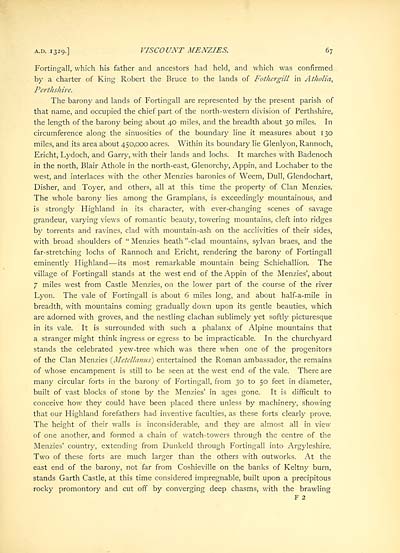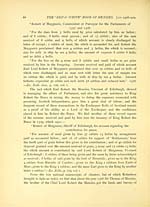Red and white book of Menzies
(111) Page 67
Download files
Complete book:
Individual page:
Thumbnail gallery: Grid view | List view

a.d. 1329.] VISCOUNT MENZIES. 67
Fortingall, which his father and ancestors had held, and which was confirmed
by a charter of King Robert the Bruce to the lands of FotJiergill in Atholia,
Perthshire.
The barony and lands of Fortingall are represented by the present parish of
that name, and occupied the chief part of the north-western division of Perthshire,
the length of the barony being about 40 miles, and the breadth about 30 miles. In
circumference along the sinuosities of the boundary line it measures about 130
miles, and its area about 450,000 acres. Within its boundary lie Glenlyon, Rannoch,
Ericht, Lydoch, and Garry, with their lands and lochs. It marches with Badenoch
in the north, Blair Athole in the north-east, Glenorchy, Appin, and Lochaber to the
west, and interlaces with the other Menzies baronies of Weem, Dull, Glendochart,
Disher, and Toyer, and others, all at this time the property of Clan Menzies.
The whole barony lies among the Grampians, is exceedingly mountainous, and
is strongly Highland in its character, with ever-changing scenes of savage
grandeur, varying views of romantic beauty, towering mountains, cleft into ridges
by torrents and ravines, clad with mountain-ash on the acclivities of their sides,
with broad shoulders of " Menzies heath "-clad mountains, sylvan braes, and the
far-stretching lochs of Rannoch and Ericht, rendering the barony of Fortingall
eminently Highland — its most remarkable mountain being Schiehallion. The
village of Fortingall stands at the west end of the Appin of the Menzies', about
7 miles west from Castle Menzies, on the lower part of the course of the river
Lyon. The vale of Fortingall is about 6 miles long, and about half-a-mile in
breadth, with mountains coming gradually down upon its gentle beauties, which
are adorned with groves, and the nestling clachan sublimely yet softly picturesque
in its vale. It is surrounded with such a phalanx of Alpine mountains that
a stranger might think ingress or egress to be impracticable. In the churchyard
stands the celebrated yew-tree which was there when one of the progenitors
of the Clan Menzies (Metellanus) entertained the Roman ambassador, the remains
of whose encampment is still to be seen at the west end of the vale. There are
many circular forts in the barony of Fortingall, from 30 to 50 feet in diameter,
built of vast blocks of stone by the Menzies' in ages gone. It is difficult to
conceive how they could have been placed there unless by machinery, showing
that our Highland forefathers had inventive faculties, as these forts clearly prove.
The height of their walls is inconsiderable, and they are almost all in view
of one another, and formed a chain of watch-towers through the centre of the
Menzies' country, extending from Dunkeld through Fortingall into Argyleshire.
Two of these forts are much larger than the others with outworks. At the
east end of the barony, not far from Coshieville on the banks of Keltny burn,
stands Garth Castle, at this time considered impregnable, built upon a precipitous
rocky promontory and cut off by converging deep chasms, with the brawling
F 2
Fortingall, which his father and ancestors had held, and which was confirmed
by a charter of King Robert the Bruce to the lands of FotJiergill in Atholia,
Perthshire.
The barony and lands of Fortingall are represented by the present parish of
that name, and occupied the chief part of the north-western division of Perthshire,
the length of the barony being about 40 miles, and the breadth about 30 miles. In
circumference along the sinuosities of the boundary line it measures about 130
miles, and its area about 450,000 acres. Within its boundary lie Glenlyon, Rannoch,
Ericht, Lydoch, and Garry, with their lands and lochs. It marches with Badenoch
in the north, Blair Athole in the north-east, Glenorchy, Appin, and Lochaber to the
west, and interlaces with the other Menzies baronies of Weem, Dull, Glendochart,
Disher, and Toyer, and others, all at this time the property of Clan Menzies.
The whole barony lies among the Grampians, is exceedingly mountainous, and
is strongly Highland in its character, with ever-changing scenes of savage
grandeur, varying views of romantic beauty, towering mountains, cleft into ridges
by torrents and ravines, clad with mountain-ash on the acclivities of their sides,
with broad shoulders of " Menzies heath "-clad mountains, sylvan braes, and the
far-stretching lochs of Rannoch and Ericht, rendering the barony of Fortingall
eminently Highland — its most remarkable mountain being Schiehallion. The
village of Fortingall stands at the west end of the Appin of the Menzies', about
7 miles west from Castle Menzies, on the lower part of the course of the river
Lyon. The vale of Fortingall is about 6 miles long, and about half-a-mile in
breadth, with mountains coming gradually down upon its gentle beauties, which
are adorned with groves, and the nestling clachan sublimely yet softly picturesque
in its vale. It is surrounded with such a phalanx of Alpine mountains that
a stranger might think ingress or egress to be impracticable. In the churchyard
stands the celebrated yew-tree which was there when one of the progenitors
of the Clan Menzies (Metellanus) entertained the Roman ambassador, the remains
of whose encampment is still to be seen at the west end of the vale. There are
many circular forts in the barony of Fortingall, from 30 to 50 feet in diameter,
built of vast blocks of stone by the Menzies' in ages gone. It is difficult to
conceive how they could have been placed there unless by machinery, showing
that our Highland forefathers had inventive faculties, as these forts clearly prove.
The height of their walls is inconsiderable, and they are almost all in view
of one another, and formed a chain of watch-towers through the centre of the
Menzies' country, extending from Dunkeld through Fortingall into Argyleshire.
Two of these forts are much larger than the others with outworks. At the
east end of the barony, not far from Coshieville on the banks of Keltny burn,
stands Garth Castle, at this time considered impregnable, built upon a precipitous
rocky promontory and cut off by converging deep chasms, with the brawling
F 2
Set display mode to:
![]() Universal Viewer |
Universal Viewer | ![]() Mirador |
Large image | Transcription
Mirador |
Large image | Transcription
Images and transcriptions on this page, including medium image downloads, may be used under the Creative Commons Attribution 4.0 International Licence unless otherwise stated. ![]()
| Histories of Scottish families > Red and white book of Menzies > (111) Page 67 |
|---|
| Permanent URL | https://digital.nls.uk/96654064 |
|---|
| Description | A selection of almost 400 printed items relating to the history of Scottish families, mostly dating from the 19th and early 20th centuries. Includes memoirs, genealogies and clan histories, with a few produced by emigrant families. The earliest family history goes back to AD 916. |
|---|

